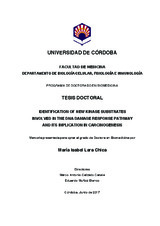Mostrar el registro sencillo del ítem
Identification of new kinase substrates involved in the DNA Damage Response pathway and its implication in carcinogenesis
| dc.contributor.advisor | Calzado Canale, Marco Antonio | |
| dc.contributor.advisor | Muñoz Blanco, Eduardo | |
| dc.contributor.author | Lara Chica, M. Isabel | |
| dc.date.accessioned | 2017-09-20T12:14:52Z | |
| dc.date.available | 2017-09-20T12:14:52Z | |
| dc.date.issued | 2017 | |
| dc.identifier.uri | http://hdl.handle.net/10396/15076 | |
| dc.description.abstract | One of the most relevant altered pathways in cancer is the DNA Damage Response (DDR), a well-coordinated network of signalling cascades that cells have developed during evolution in order to maintain genomic integrity. These pathways are activated when genomic material is damaged with the aim of transmit the damage signals to effector proteins, and induce cellular responses including cell cycle arrest, activation of DNA repair pathways, and cell death; thus preventing tumorigenesis. CHK2 and DYRK2 are key downstream kinases of the DDR, involved mainly in the regulation of cell cycle and DNA repair. The identification of new substrates for these kinases will delve into knowledge of their functions within the DDR, which leads to tumor development and progression when deregulated. In the present work we demonstrate how CHK2 presents the ability to phosphorylate the E3 Ubiquitin ligase SIAH2, affecting its activity on certain substrates. Additionally, SIAH2 regulates CHK2 basal turnover through ubiquitination and proteasomal degradation. In response to DNA damage, the interaction between both proteins is disrupted, which favors CHK2 stabilization. This new CHK2 regulation mechanism has an influence on cell cycle progression and on the ability of hypoxia to alter DDR pathway in cancer cells, since resistance to apoptosis induced by genotoxic agents in cells subjected to hypoxia could be partly explained by the mutual regulation between CHK2 and SIAH2. We also describe the capacity of DYRK2 to modulate the turnover of the checkpoint phosphatase CDC25A through an ubiquitin/proteasome and DYRK2 kinase activity dependent process. DYRK2 directly phosphorylates CDC25A in vitro, although DSG or KEN motifs are not involved in the CDC25A degradation by the proteasome mediated by DYRK2. Different stimuli, such as DNA damage or serum starvation, result in an inverse correlation of DYRK2 and CDC25A expression, which is also observed at endogenous levels in human lung cancer cell lines and human lung cancer tissues. Taken together, our findings report new substrates (SIAH2 and CDC25A) for two relevant kinases involved in the DDR pathway (CHK2 and DYRK2), helping to elucidate the molecular mechanisms through which this pathway operates. These data certainly help to improve the understanding of the regulation processes of these relevant kinases and will extend the knowledge about the molecular biology of cancer as well as provide new therapeutic opportunities for cancer treatment. | es_ES |
| dc.format.mimetype | application/pdf | es_ES |
| dc.language.iso | eng | es_ES |
| dc.publisher | Universidad de Córdoba, UCOPress | es_ES |
| dc.rights | https://creativecommons.org/licenses/by-nc-nd/4.0/ | es_ES |
| dc.subject | Cancer cells | es_ES |
| dc.subject | Carcinogenesis | es_ES |
| dc.subject | Kinases | es_ES |
| dc.subject | DNA Damage Response | es_ES |
| dc.subject | CHK2 | es_ES |
| dc.subject | DYRK2 | es_ES |
| dc.subject | Substrates | es_ES |
| dc.subject | SIAH2 | es_ES |
| dc.subject | CDC25A | es_ES |
| dc.subject | Molecular biology | es_ES |
| dc.title | Identification of new kinase substrates involved in the DNA Damage Response pathway and its implication in carcinogenesis | es_ES |
| dc.type | info:eu-repo/semantics/doctoralThesis | es_ES |
| dc.rights.accessRights | info:eu-repo/semantics/openAccess | es_ES |

